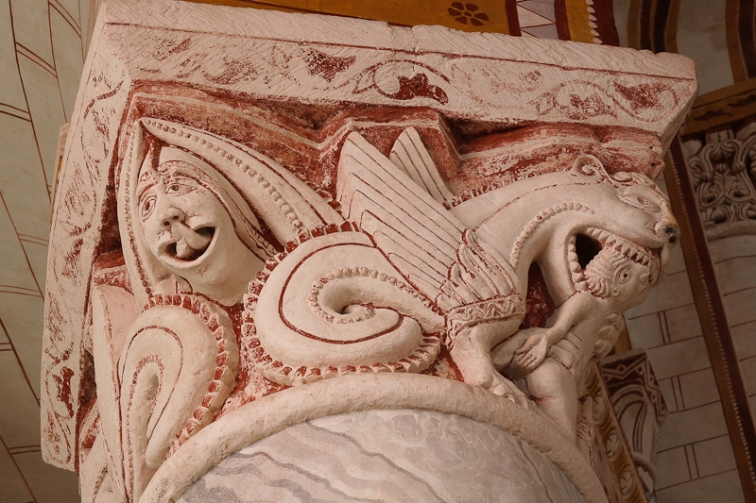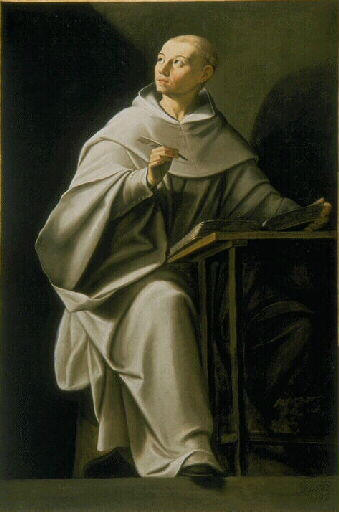✜ Note – after the depressing post about the sack of Béziers, I thought something a little more lighthearted might be in order. I therefore repost this April 2010 essay on Bernard of Clairvaux and Abbot Suger. ✜

The great Bernard of Clairvaux was a reformer and a strict adherent to the austere monastic life. Not for him an appreciation of the wonderful, playful, imaginative capitals that decorated the tops of columns in Romanesque churches throughout Europe. In his “Apologia” to William, Abbot of Saint Thierry in 1125, the Abbot of Clairvaux wrote, “But in cloisters, where the brothers are reading, what is the point of this ridiculous monstrosity, this shapely misshapenness, this misshapen shapeliness? What is the point of those unclean apes, fierce lions, monstrous centaurs, half-men, striped tigers, fighting soldiers and hunters blowing their horns? In one place you see many bodies under a single head, in another several heads on a single body. Here on a quadruped we see the tail of a serpent … In short, so many and so marvelous are the various shapes surrounding us that it is more pleasant to read the marble than the books, and to spend the whole day marveling over these things rather than meditating on the law of God. Good Lord! If we aren’t embarrassed by the silliness of it all, shouldn’t we at least be disgusted by the expense?”

Fortunately for us, Bernard was in the minority, for one of the glories of Romanesque sculpture are these “unclean apes, those fierce lions” and the rest of the comely deformed.
One of the great ironies of medieval life is the relationship between Bernard of Clairvaux and his great friend, Abbot Suger. Suger is the single figure most responsible for the transition from Romanesque to Gothic architecture, the guiding force behind the Abbey Church of Saint-Denis, outside of Paris. Not only is Saint Denis the birthplace of the Gothic, but it is the final resting place of French Kings from Dagobert through Louis XVI. Abbot Suger was the patron of the Gothic architecture, inviting all the great prelates in Europe to the unveiling of his splendid new church that featured soaring arches, huge jeweled stained glass windows penetrating the walls, and a beauty and perfection that stands to this day as a monument to the inspiration of man. He filled the church with golden vessels and luxurious ornaments, honoring his Lord with the most rare and precious materials. Peter the Veneble, the Abbot of Cluny, viewed the marvels of the Church and announced, “This man condemns us all. He builds, not for himself, but for God alone.”

As the creator and sponsor of such beauty, one would never expect Suger’s great friendship and abiding love for the ascetic Bernard who decried the expense and distraction of these churches. But it was Bernard himself who suspected in the worldly Suger a deeper calling for the church. Bernard had seen Suger riding with his entourage of sixty horsemen and admonished him, “One would think it was a governor of a province, not of souls.” The words inspired Suger to a deeper, more profound religious commitment. He reformed himself, then his abbey, and then he rebuilt Saint Denis.

Both of these men glorified their God, but they took different roads, roads that symbolized precisely the path chosen by the medieval church. For both, the goal was the glory of God. For Abbot Suger it was to honor and praise Him, to inspire others to honor and praise Him. For Bernard, it was to serve, and to inspire others to serve. They met at the grounds of devotion and inspiration, true inspiration and love. They recognized this in each other and it was the basis of a relationship that lasted throughout their lives. Upon hearing of Suger’s death, Bernard wrote to Eugenius III, “If there is any precious vase adorning the palace of the King of Kings it is the soul of the venerable Suger”.
When the Abbot of Saint Denis lay dying, he wrote to Bernard, “Could I but see your angelic face before I die, I should go with more confidence.” Bernard wrote back, asking that when he arrived in Heaven, Suger “think of him before God”. I would like to think that when Suger contemplated doing so, he imagined heaven to be like his glorious abbey church, with soaring walls, vaults and jeweled light, not the sheltering, earthbound walls of Bernard’s Clairvaux and Fontenay. For in this, he knew better than Bernard, and the knowledge must have made him smile.
And Bernard, standing in Saint Denis with the brilliant light playing on his white robes, probably knew so as well.
If you are interested in seeing more of these Cistercian monastery churches, please see the Via Lucis website. And if you are interested in learning about Bernard of Clairvaux as a man, what better way than to read his eulogy for his brother Gerard. It may be long, but it is a full glimpse into the heart of Bernard (Text starts at II3.)

Beautiful light captured and presented perfectly- so difficult to do.
Another insightful post, and stimulating photos. I appreciate the friendship of the two men. Both are absolutely necessary, and each fills a role that the other could not.
Ann, this is what I loved when I discovered this a few years ago. Bernard was at the unveiling of the new Saint Denis – can you imagine his reaction? And I love the image of the lights on his white robes.
Dennis, I would love to see you publish a book. I’ll help put it together just to get a shot at getting a signed copy.
Harushi, we are working on Light & Stone now, rounding into final form to present it to publishers. Careful, I just might take you up on this – how long it has been since we worked together (just the other day I was thinking of thousands of brush strokes!).
That first photo brought a smile to my lips–I studied with Michael Camille in the years just after he published IMAGE ON THE EDGE, and I never cease to think of him when I see fanciful decorations like those! I suspect that, if Bernard and Suger’s heaven exists, Camille is up there grilling them for information about what they both wrote.
Your stories make me remember my training as a medievalist! (I haven’t worked in the field in ages, but I remember all of it very, very fondly!!)
“Image on the Edge” is a wonderful book, thanks for bringing it up. I would like to think that there are some great conversations among Suger, Bernard and Camille – Camille was certainly called up too early. PJ and I love these grotesques and the distinction between “real” life and “carnival” life.
And how is this image from the Cathédrale Saint Etienne in Cahors for an example of medieval marginalia?
I enjoyed your informative and entertaining essay on Bernard and Suger. Thank you for reposting, Dennis. While Suger is generally credited with bringing the Gothic style into being in 1144 at St. Denis, I am also reminded that Suger kept the name of his master builder under wraps, even as he had his own name etched in stone. What a vain man Suger must have been. Jong-Soung
Jong-Soung, Linda Seidel used this behavior as evidence that Giselbertus was not the sculptor of the tympanum of Autun, but its benefactor. I think that is a bit thin, especially since “Gofridus me fecit” is inscribed on the capitals in Chauvigny. Can’t imagine that anyone but the inspired sculptor would sign the Assumption capital in that way. As far as Suger’s vanity, Bernard did catch him with a retinue of sixty mounted men.
Thanks as always for your comments, contributions, and attention.
I shall come back and read this again when I have more time (off to a poetry workshop). My school was Saint Bernard’s Convent, and we learned a lot about him there, most of which I had forgotten until now! I do remember the chapel as over-ornate rococo, but it was a very long time ago.
Viv, can you imagine making the Saint Bernard Convent an ornate rococo? Where was the school?
Thank you, thank you, for this splendid site! I am a docent at Grace Cathedral in San Francisco and have always been drawn to sacred space, especially medieval France. So thank you for taking me to such wondrous new places and insights. I’m intrigued by the Suger/Bernard connection.
Thank you, Judy. We are very fond of Grace Cathedral and it is on our list of American churches to photograph. And if you like Romanesque churches in France and Spain, boy have you come to the right place! We are returning to France in the Fall for seven weeks to shoot again and are itching to be on our way. Perhaps when we come to San Francisco we can have you show us around Grace Cathedral!
I’ll be waitiingt!!!
Under the good influences of Via Lucis (I’m a loyal follower of this awesome blog) , I have posted my own collection of Romanesque “happy monsters” (canecillos in Spanish) on my blog “Covetotop”. I took those pics in rural churches, hidden hermitages and monasteries across Spain. A wonderful experience.
I’m on my way over to look. Thanks for the heads up and for the kind words.
A year later, I find myself dancing all over your blog, linking back and forth as I build on my knowledge from your incredible sourcebook. It’s not just your exquisite photography that draws me in, Dennis. It’s the personal stories and rich history that rounds out the pictures and gives life to the period. Who were the people who prayed in these buildings? That’s the part that intrigues me.
Judy, glad that you are able to dance across the blog. We have covered quite a bit of ground in our three and a half years and our 100,000 photos of 700 churches. The good news for PJ and myself is that there are 5000 Romanesque churches in France and 1500 in Spain, so it doesn’t look like we’ll be running out of material any time soon. Thanks for your kind words; it makes the effort worthwhile.